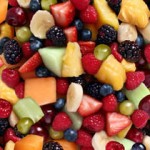Fancy a healthy Christmas treat? Why not try making the Fruity Christmas Tree instead of the usual Christmas candy gingerbread house?
You can use any fruits you like - just remember to keep it colourful!
Skills Check
Follow a recipe; follow food safety & hygiene rules; tidy away; chop using bridge/claw safely; decorate and garnish.
Allergens
None
Equipment
1 styrofoam cone (25 cm) can be found in craft stores or online, cocktail sticks, assortment of cookie cutter shapes including stars, knife, chopping board, serving plate.
Ingredients (makes 1 tree):
- 1 kiwi
- 6 strawberries
- 1 satsuma
- cantaloupe melon (1 slice)
- Green and red grapes (10 grapes)
- Bunch of mint
Method
- Wash and prepare the fruit.
- Cut 1 cm slices of the melon. Using the cookie cutters cut a variety of shapes from the flesh, including a star for the top of the tree.
- Place the cone on a small plate and beginning at the bottom insert toothpicks into the cone and stick pieces of fruit onto the sticks.
- Continue working upwards placing fruits in a visually appealing way, using the grapes to fill smaller spaces between the larger pieces of fruit.
- Place a cocktail stick vertically in the top of the cone and place a melon star on top.
- Spread mint leaves around the base of the tree to cover the plate, tucking it up and under the fruit.
So thinking about Fruity Christmas Trees ...

Nutritional Information
| - | Energy | 382kJ/91kcal | 5% |
| Low | Fat | 0.5g | <1% |
| Low | Saturates | 0.0g | <1% |
| Med | Sugar | 1 | 19% |
| Low | Salt | Trace | <1% |
per 231g serving (1/2 a tree)
% of an adult's reference intake
Typical values per 100g: Energy 166KJ / 39kcal
Notes
A traffic light system is used on nutrition labels to make it easier to see which foods and drinks are lower in calories, fat, sugar and salt. Try and choose more ‘greens’ and ‘ambers’ and fewer ‘reds’, and stick to smaller portions of ‘reds’.
Just because a recipe or a food has a red traffic light doesn't mean you shouldn't eat it. Understanding why a food or recipe might have a red light can be helpful. For example oily fish is high in total fat and so any recipe containing oily fish is likely to be ‘red’ for fat. But it is recommended that we eat oily fish at least once a week because the type of fat it contains is beneficial for our health.
% Reference Intakes are also shown. Reference Intakes are guidelines about the approximate amount of particular nutrients and energy required for a healthy diet (based on an average-sized woman doing an average amount of physical activity). Most children will require less than these Reference Intakes. The contribution of one serving of a food or drink to the Reference Intake for each nutrient is expressed as a percentage.


